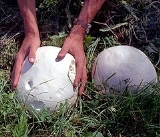
Lycoperdales
Encyclopedia
The Lycoperdales are a now outdated order
of fungi
. The order included some well-known types such as the giant puffball
, the earthstar
s, and other tuberous fungi. They were defined as having epigeous basidiomes, a hymenium
present, one to three layers in the peridium (outer wall), powdery gleba
, and brown spores.
The restructuring of fungal taxonomy brought about by molecular phylogeny
has divided this order . Most of its members have been placed in family Lycoperdaceae
of order Agaricales
, while the earthstars and similar species now occupy family Geastraceae
of order Phallales
.
Order (biology)
In scientific classification used in biology, the order is# a taxonomic rank used in the classification of organisms. Other well-known ranks are life, domain, kingdom, phylum, class, family, genus, and species, with order fitting in between class and family...
of fungi
Fungus
A fungus is a member of a large group of eukaryotic organisms that includes microorganisms such as yeasts and molds , as well as the more familiar mushrooms. These organisms are classified as a kingdom, Fungi, which is separate from plants, animals, and bacteria...
. The order included some well-known types such as the giant puffball
Giant puffball
Calvatia gigantea, commonly known as the Giant puffball, is a puffball mushroom commonly found in meadows, fields, and deciduous forests worldwide usually in late summer and autumn. It is common throughout Europe and North America.-Description:...
, the earthstar
Geastraceae
The earthstars are the family Geastraceae of gasterocarpic basidiomycetes . It includes the genera Geastrum and Myriostoma. About sixty-four species are classified in this family, divided among eight genera....
s, and other tuberous fungi. They were defined as having epigeous basidiomes, a hymenium
Hymenium
The hymenium is the tissue layer on the hymenophore of a fungal fruiting body where the cells develop into basidia or asci, which produce spores. In some species all of the cells of the hymenium develop into basidia or asci, while in others some cells develop into sterile cells called cystidia or...
present, one to three layers in the peridium (outer wall), powdery gleba
Gleba
Gleba is the fleshy spore-bearing inner mass of fungi such as the puffball or stinkhorn.The gleba is a solid mass of spores, generated within an enclosed area within the sporocarp. The continuous maturity of the sporogenous cells leave the spores behind as a powdery mass that can be easily blown away...
, and brown spores.
The restructuring of fungal taxonomy brought about by molecular phylogeny
Molecular phylogeny
Molecular phylogenetics is the analysis of hereditary molecular differences, mainly in DNA sequences, to gain information on an organism's evolutionary relationships. The result of a molecular phylogenetic analysis is expressed in a phylogenetic tree...
has divided this order . Most of its members have been placed in family Lycoperdaceae
Lycoperdaceae
Lycoperdaceae is a family of approximately 150 fungi now known to lie in the Agaricales. Historically they were placed in their own order Lycoperdales. Members of the Lycoperdaceae family are known as the true puffballs. Unlike other types of fungi that hold spores in gills or teeth, puffballs...
of order Agaricales
Agaricales
The fungal order Agaricales, also known as gilled mushrooms , or euagarics, contains some of the most familiar types of mushrooms. The order has 33 extant families, 413 genera, and over 13000 described species, along with five extinct genera known only from the fossil record...
, while the earthstars and similar species now occupy family Geastraceae
Geastraceae
The earthstars are the family Geastraceae of gasterocarpic basidiomycetes . It includes the genera Geastrum and Myriostoma. About sixty-four species are classified in this family, divided among eight genera....
of order Phallales
Phallales
The Phallales are an order of fungi that is more or less synonymous with the gomphoid-phalloid clade. The order contains two families, the Claustulaceae and the Phallaceae, which collectively contain 26 genera and 88 species.-External links:...
.

